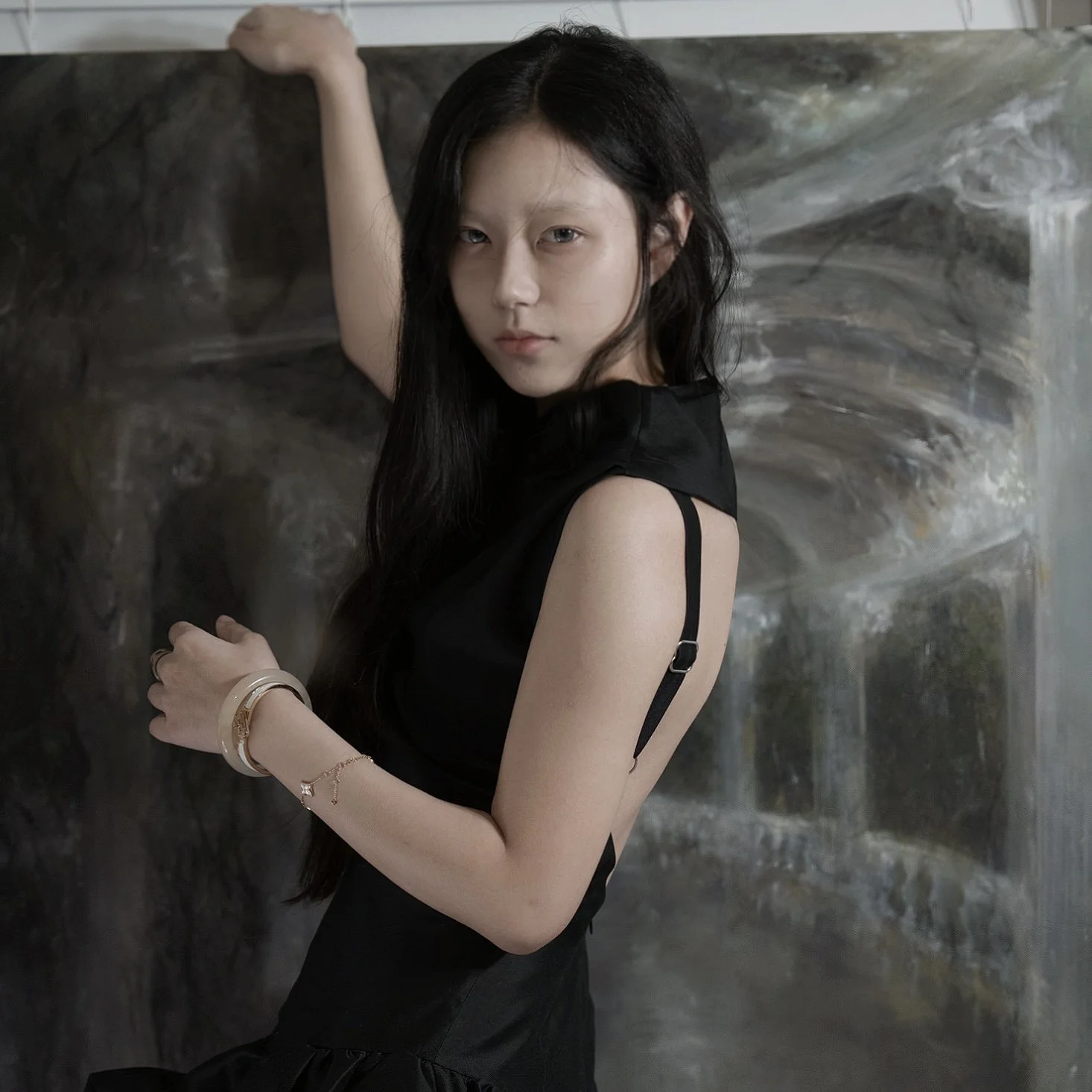10 Questions with Siyu Zhong
Siyu Zhong is an emerging oil painter whose work blends surrealism, liminal spaces, and Daoist philosophy into a unique visual language. Growing up in China, they were fascinated by the quiet mystery of nature and the way memories can feel like shifting landscapes. This sense of fluidity and in-between spaces continues to shape her art.
Zhong’s paintings have gained popularity on Chinese art platforms, resonating with audiences for their dreamlike atmosphere and emotional depth. They are always exploring new ways to push the boundaries of perception, using oil paint to create layered, immersive worlds. As their practice evolves, Zhong remains driven by a deep curiosity about the unknown and a desire to connect with viewers through art that feels both personal and universal.
Oil painting is at the heart of my artistic practice—it allows me to build depth, atmosphere, and emotion in a way that feels both timeless and tactile. By reinterpreting natural forms in surreal and ethereal ways, I invite audiences to question what is real, what is imagined, and how art can exist between the two.
Siyu Zhong - Portrait
ARTIST STATEMENT
Siyu Zhong is an emerging oil painter whose work explores the delicate balance between reality and imagination. Influenced by surrealism, liminal spaces, and Daoist philosophy, Zhong reinterprets natural forms in dreamlike compositions that challenge conventional perceptions of space and time. Through layered brushstrokes and atmospheric depth, their paintings evoke a sense of mystery and transcendence.
Oil painting serves as the foundation of Zhong’s artistic practice, allowing for a tactile and timeless expression of emotion. By transforming familiar subjects into ethereal, otherworldly landscapes, their work invites viewers to question the boundaries between the real and the imagined. With a growing presence on Chinese art platforms and a distinct visual language, Zhong’s art continues to resonate with audiences seeking profound and thought-provoking experiences.
Dog Hide in Lotus Leaves, Oil on Canvas, 30 x 48 in, 2024 © Siyu Zhong
INTERVIEW
First of all, can you tell us about your background and how you first became interested in painting?
I was born in Beijing in 2002 and moved abroad to study at the age of 14. Growing up, I was always drawn to visual storytelling, especially through books and animated films. I started painting more seriously in middle school as a way to process the emotional complexity of being away from home and navigating two cultures. Painting became my sanctuary—something I could return to when I felt overwhelmed or disconnected. Over time, it turned from a personal outlet into a more deliberate practice of exploring memory, identity, and emotion.
How has growing up in China influenced your artistic vision and subject matter?
Growing up in China, I was surrounded by a deep cultural appreciation for nature, symbolism, and philosophy, especially in traditional ink painting and literature. I was also influenced by Daoist ideas of harmony, emptiness, and flow, which continue to shape how I think about space and perception. At the same time, the rapid urbanisation of Beijing made me acutely aware of contrasts between old and new, nature and concrete, quiet and chaos. My home in Beijing sits at the intersection of the modern city and ancient relics, right next to a 300-year-old park that I used to pass by on my way to school. These contrasts often appear in my work as layered spaces that feel both comforting and unsettling. I’m especially interested in how familiar places become strange when seen through the lens of memory or distance, especially as someone who left home at a young age.
Some Run in Serenity, Oil on Canvas, 30 x 48 in, 2024 © Siyu Zhong
To Your Mountain, Oil on Canvas, 30 x 48 in, 2024 © Siyu Zhong
What drew you to oil painting as your primary medium?
Oil paint has a tactile, slow quality that really suits how I like to work. I enjoy building up textures and layers—it allows me to capture depth and atmosphere in a way that feels immersive and emotional. I usually don’t create drafts; I tend to have a strong sense of direction before I lay down my first stroke, and then I let my emotions guide me. There’s also something timeless and unpredictable about oil—it often surprises me in ways I can’t control, which I find beautiful. Even when I experiment with digital elements like AR or projection, oil remains the core of my practice because of its physicality. It grounds my ideas and gives me the space to think through feeling.
How do surrealism, liminal spaces, and Daoist philosophy shape your work?
It often begins with a fleeting image or emotion—something I remember from a dream, a childhood memory, or a moment of longing while walking outside. I often stop randomly to take photos while wandering, collecting inspiration along the way. I then build the composition digitally, experimenting with surreal elements. Once I have a rough sense of direction, I transfer it to canvas and let the painting evolve through layering and adjustment. Music, poetry, and even silence are important to my process. I try not to rush—each layer carries emotional weight and guides the next step. The process is meditative and helps me process personal themes like nostalgia, solitude, or the tension between presence and absence.
Ghost of Her Chair, Mix Medium, 12 × 12 in, 2025 © Siyu Zhong
Can you describe your creative process? What usually inspires a new painting?
It often begins with a fleeting image or emotion—something I remember from a dream, a childhood memory, or even a moment of longing while walking outside. I often randomly stop and take photos when wandering outside. I collect inspiration from my photos, then begin building the composition digitally to experiment with surreal elements. Once I have a rough sense of where I am going, I transfer it to canvas and let the painting evolve through layering and adjustment. Music, poetry, and silence are important to my process. I try not to rush—each layer carries emotional weight and guides the next step. The process is meditative, allowing me to process personal themes like nostalgia, solitude, or the tension between presence and absence.
Your work often blurs the line between reality and imagination, as you mention in your statement. What do you hope viewers feel or experience when looking at your art?
I hope viewers feel a kind of gentle disorientation, like they’ve entered a space that’s familiar yet strange, quiet yet emotionally charged. I want them to reflect on their own memories and emotions and perhaps find resonance in that in-between space. My work isn’t about telling a specific story; it’s about creating a mood or atmosphere that invites introspection. I also hope they feel a sense of softness and care—that even when the themes are melancholic, there’s always a thread of beauty, curiosity, or longing that connects us.
How do you approach creating the dreamlike atmosphere that defines your paintings?
I rely heavily on soft, blended brushstrokes, diffused light, and layered textures to create that sense of dreaminess. I often use muted or monochromatic palettes to enhance mood and shift focus away from realism. The way I structure space—flattening certain areas while creating deep pockets in others—helps blur the boundary between real and imagined. I also play with perspective, shadow, and scale to create surreal tension without overwhelming the viewer. It’s all about balance—inviting the viewer to pause and feel suspended in time.
In Remembrance of the Family, Oil on Canvas, 12 × 12 in, 2024 © Siyu Zhong
Pale Star, Mixed media, 4 x 4 in, 2025 © Siyu Zhong
What role does nature play in your visual storytelling?
Nature is both a subject and a metaphor in my work. Plants, animals, fog, and water often appear as symbolic elements—carriers of memory, change, or emotion. Growing up surrounded by traditional Chinese gardens and natural landscapes, I’ve always felt that nature holds a kind of spiritual resonance. In my paintings, natural forms often become extensions of feeling, like lotus leaves that envelop a dog hiding in solitude, or a pond that reflects something beyond the visible. Nature becomes a space where the boundaries of self and world can dissolve.
How has your work been received by audiences so far, especially on Chinese art platforms?
I’ve been fortunate to receive very positive feedback on Chinese art platforms. Viewers often comment on the emotional depth and dreamlike quality of my paintings. Many say the work reminds them of their own childhood memories or inner worlds—something bright yet tinged with melancholy—which means a lot to me. I think there’s a growing appreciation for art that combines tradition with a contemporary, psychological edge, especially among younger audiences. It’s encouraging to know that something so personal can resonate so widely.
And lastly, are there any upcoming projects or themes you’re excited to explore in your future paintings?
Yes! I’m currently working on a new series that explores the idea of “returning”—not just to a physical place, but to emotional states, relationships, and identities. I want to dive deeper into how the places we once called home evolve in our memory, and how we carry those shifts in our bodies and dreams. I’m also experimenting more with integrating AR components into my paintings, creating interactive layers that extend the work beyond the canvas. The goal is to further immerse viewers in these in-between worlds and explore how technology can heighten the emotional and spatial experience of painting.
Artist’s Talk
Al-Tiba9 Interviews is a promotional platform for artists to articulate their vision and engage them with our diverse readership through a published art dialogue. The artists are interviewed by Mohamed Benhadj, the founder & curator of Al-Tiba9, to highlight their artistic careers and introduce them to the international contemporary art scene across our vast network of museums, galleries, art professionals, art dealers, collectors, and art lovers across the globe.





















